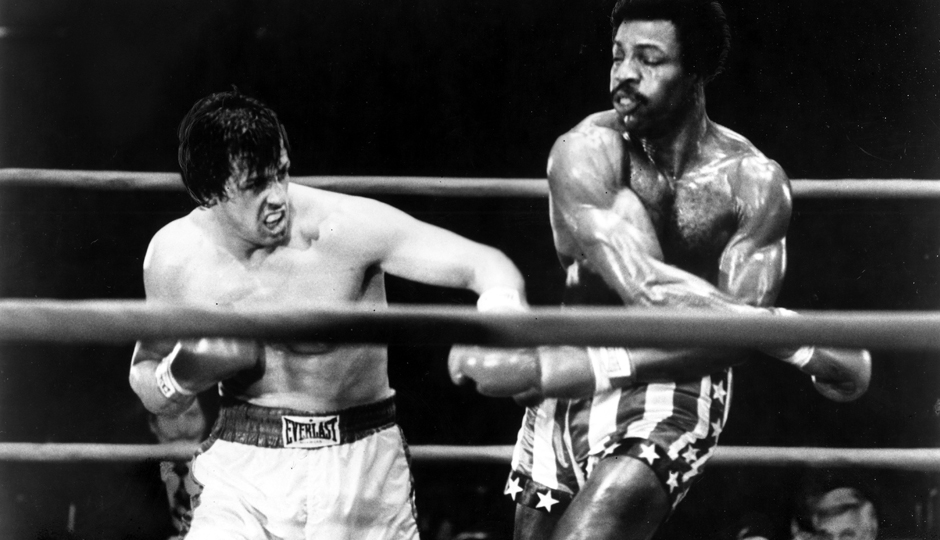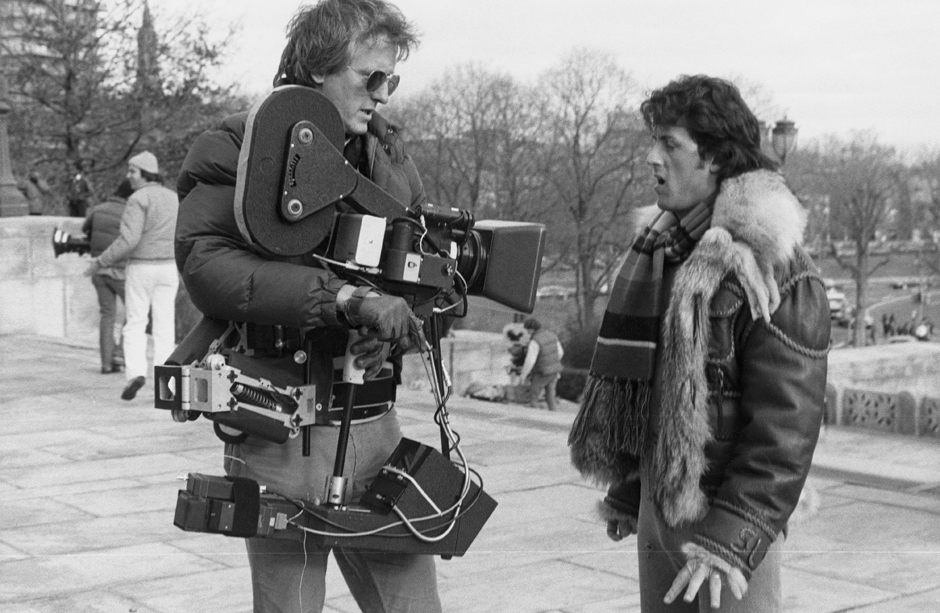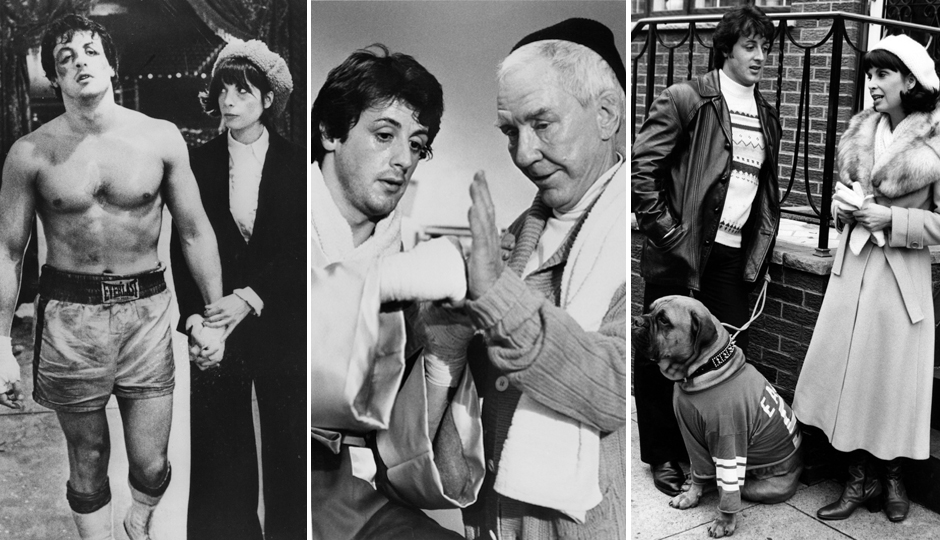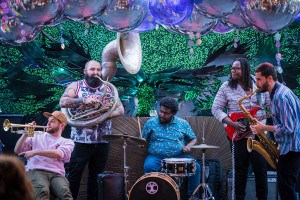Rocky: An Oral History
On December 3, 1976, a low-budget movie set in Philly starring an actor no one knew opened in theaters nationwide. Forty years later, for better or for worse, our city's identity is intractably entwined with Hollywood's most beloved underdog story. Here's how it all came to be.

Actors Sylvester Stallone and Carl Weathers in the final fight in Rocky | Photo: Michael Ochs Archives/Getty Images
I. The Setup
IRWIN WINKLER, producer: My partner, the late Robert Chartoff, and I interviewed Sly Stallone as an actor for another picture, and he told us he was also a writer. He sent us one script, but we weren’t interested. He said, “I have another idea.” And then he proceeded to tell us about Rocky.
JOHN AVILDSEN, director: Sylvester had auditioned for me a couple of times. Neither time did he get a job. Then in 1975, a friend sent me the script for Rocky. I had no interest in boxing, but the script charmed me. I didn’t think of it as a boxing movie any more than Gone with the Wind was a Civil War movie.
SYLVESTER STALLONE explaining in a 1976 New York Times interview how he wrote the script after seeing Chuck Wepner box Muhammad Ali: I was watching the fight in a movie theater, and I said to myself, “Let’s talk about stifled ambition and broken dreams and people who sit on the curb looking at their dreams go down the drain.” … I wrote it in three and a half days. … I just don’t believe these guys who say it takes them 19 years to write something.
IRWIN WINKLER: The script really allowed this to be a low-budget film. It had to be realistic. It was just that kind of movie. No big stars. No big sets. A very unusual subject of a broken-down fighter who gets the chance of a lifetime.
TALIA SHIRE, “Adrian”: I’d just had a baby when that script came in the mail. I had no idea who this person was who wrote it. But it was brilliant—the language, the written text of that piece, the poetry that Sylvester composed. He had truly created a folk myth.
BURT YOUNG, “Paulie”: I was hanging out in my bowling alley in Queens the first time I read it. I knew it was a home run. How does a stumblebum wind up fighting for a championship? I used to be a fighter. It don’t happen. It’s a fairy tale done for grown-ups.
IRWIN WINKLER: The studio didn’t want to make the film, but they said they would if we could get a big star—Burt Reynolds or Ryan O’Neal or Robert Redford. But our arrangement with Sly was that he wrote it and he would star in it. But the whole idea of it—a fight film was not particularly something people would go see without a star in it. And he loses the fight in the end! Plus, these were not the most attractive people in the world. But eventually, the studio relented.
TALIA SHIRE: They really didn’t want Sylvester to play the lead, and he was offered money for the script outright. But he refused. He had conviction. I realized that he had great focus and courage in not selling that script. He had a pregnant wife. He had nothing.
SYLVESTER STALLONE in a 1976 interview with the New York Times: I never would have sold it. … I told my wife that I’d rather bury it in the backyard and let the caterpillars play Rocky. I would have hated myself for selling out, the way we hate most people for selling out. My wife agreed, and said she’d be willing to move to a trailer in the middle of a swamp if need be.
TALIA SHIRE: The role of Adrian resonated for me. I’m shy, so I understood her. I went into the audition—and I do not audition well—and there was an immediate connection with Sylvester and myself, a creative partnership.
IRWIN WINKLER: We had a lot of people come in and test for the role of Apollo Creed. Carl [Weathers] was just incredible.
JOHN AVILDSEN: When Burgess [Meredith] came in to audition for Mickey, we auditioned that first scene where Rocky complains about losing his locker. We tried it a couple of times, and then I said, let’s just improvise it and put the script down. So he and Sylvester went through the scene again, and when Rocky is supposed to turn and walk away, Burgess said, “Rock, you ever think about retiring?” Sylvester never wrote that, but that’s exactly what the guy would say.
BURT YOUNG: I was the only actor that didn’t audition. I’d worked with the producers before, and they wanted me from the beginning. I really just had to take the normal lack of quality that I have and slow it down. That’s Paulie.
JOHN AVILDSEN: I said yes in September of ’75, and my sons and I went to Philadelphia and looked at locations. I had never been there before. But the city was great: just the right size, a Goldilocks kind of town, and historic.
TALIA SHIRE: Never forget that this was supposed to be a celebration in the birthplace of America—1776, 1976. You can’t forget that. Because that is the frame around this mythological piece that gave it its mythos.
IRWIN WINKLER: Philadelphia is a big, great American city, yet it feels intimate. Much more personal than New York or Chicago or L.A.
SYLVESTER STALLONE: And Philadelphia is a great fight town that makes working-class heroes.
JOHN AVILDSEN: The problem was, we had a very low budget of about a million bucks. The producers said we couldn’t afford to go to Philly with a union crew from L.A., but I told them I had a terrific non-union crew from New York that we could sneak in. So that’s what we did. We started shooting on November 5, 1975.

Steadicam inventor Garrett Brown and Stallone filming Rocky II in 1978. | Photo: Garrett Brown
II. The Shoot
JOSEPH MARKS, former owner of J&M Tropical Fish in Kensington: A few gentlemen walked into the pet store in 1975 and asked if we’d let them use the store for a major motion picture. We got paid maybe $1,500.
TALIA SHIRE: John gave me money to go to a thrift store. I got those glasses and a coat, and I put Adrian together with that hat. Sylvester created a unique character, and my job was to partner with him like a ballet dancer. Here’s where I lift him up. Here’s where I put him down.
BURT YOUNG: I wanted to be fatter, so I made them put pads in my undershirt. And I put vermouth on my neck so I would smell like cheap wine. This guy is half a waste, I wanted to remind myself.
JOHN AVILDSEN: In the original script, Adrian and Rocky went on their first date to a cafe and talked for seven or eight pages. I thought that was deadly, and I said, let them go bowling or ice-skating.
TALIA SHIRE: We had no money. I was in this big truck in Philadelphia with Burgess, very cold weather. There were cables and everything in there. It was just mirrors slapped on a wall. Burgess looked at me and said, “Isn’t this great? Isn’t this wonderful?” And he meant it. Everything was based on a budget, and the lack of budget became golden. That ice- skating sequence … we couldn’t afford to shoot in Philly, so Sylvester had a friend open a rink for us in L.A.
JOSEPH MARKS: I didn’t sell dogs, because you’d need a kennel license. So they brought in dogs from another shop and put them in the window. They brought in the turtles—Cuff and Link—but they left them with me.
JOHN AVILDSEN: We were constantly changing things. For instance, when Rocky goes in to see the promoter and he thinks he’s going to be a sparring partner and the promoter says, no, we want you to fight Apollo Creed, originally Rocky says, “I’ll do my best.” But I realized that Rocky was not a dumb guy. He was smart. And he would say no. He would say he had no business fighting Apollo Creed. And then the audience felt more sympathy, because he’s being taken advantage of. The promoter conned him.
GARRETT BROWN, Philadelphia filmmaker and inventor of the revolutionary Steadicam, which was used in just one movie before Rocky: We shot in L.A., but we also shot all over Philly: Stallone on his running program, down by the Schuylkill, the Art Museum, riding around the seedy railroad yards. And of course the scene from the Italian Market. Usually, we were as anonymous as a homeless person. No one knew who we were or what we were doing. These days, try to shoot a movie in Philadelphia with Sylvester Stallone.
Behind-the-scenes 8mm footage from the Rocky shoot in Philadelphia, 1975:
EMILIO MIGNUCCI, co-owner, Di Bruno Bros.: I went to school on Christian between 9th and 10th. We were in school when we heard they were filming on the street and at Pat’s. We didn’t know who it was or anything, but it was a movie. The priest let the whole school out early. I was in first grade. At the end of the market scene, I’m somewhere in the back of the pack of kids running after Stallone.
GARRETT BROWN: On 9th Street, I was in a van ahead of Sly for one of the first real vehicle shots ever made. The point of the Steadicam was to be able to follow Sly while stabilizing the shot on that terrible road. Stallone was running up the street like there was not a care in the world. Someone spontaneously threw him that apple—and he caught it!
RIITAMARIE OLIVIERI, co-owner, Pat’s Steaks: We had a lot of kids from the neighborhood that were used as extras, and they kept getting sandwiches. After a while, their eyeballs were popping out of their heads, they ate so many cheesesteaks. The priest was running the steaks across the street and stocking up in a freezer in the rectory.
JOHN ALVIDSEN: Sylvester knew exactly where he wanted to shoot. He spent part of his childhood in Philadelphia. He knew the city, and the movie was always going to be set and filmed there.
GARRETT BROWN: Another great shot is when Sly is running down by the waterfront and he accelerates and the Moshulu appears in the background. We didn’t realize how amazing it looked at first, because we were all watching on this crappy monitor in the van. We didn’t mess with the speed of the film. That is how fast he went. Then we heard that they were thinking of turning it into a restaurant.
JOHN AVILDSEN: With the scene at the Art Museum steps, I really didn’t know how I was going to do that at first.
GARRETT BROWN: I had circulated a demo of footage I shot with the Steadicam in 1974. The last shot we made was me following my girlfriend—now wife—Ellen down and then back up the Art Museum steps. That got Avildsen in touch with us. He wanted to know how we did it, because he was prepping a little B-picture called Rocky.
Garrett Brown Steadicam footage, including excerpts from the 1974 demo reel, Rocky, and the Shining:
JOHN AVILDSEN: I’m looking at this reel of his, and there’s his girlfriend running on the steps. And I said, Aha! That’s how I’m going to do that. The contribution that Garrett’s Steadicam made to the movie is immeasurable.
SAM KATZ, filmmaker, History Making Productions: The most significant player in this whole story, I believe, is Garrett Brown. He changed the way we watched sports—through NFL Films—and Rocky was the pivotal moment in that.
GARRETT BROWN: They offered me points in the picture. But I was too smart, and I said, oh no, I want my crappy salary; I don’t want points. That cost me a lot of money.
BURT YOUNG: At the Art Museum, Sylvester and me were sharing a trailer. We didn’t have no money. We were just trying to get it done. We step out of the trailer, and he took a breath like a deep sigh, like Here we go for real now. It was a great sigh.
JOHN AVILDSEN: Eventually, we got kicked out of Philadelphia by the unions.
IRWIN WINKLER: I heard there was a generator “breakdown” that was caused by the unions.
JOHN AVILDSEN: We had to go back to L.A. Supposedly the fight at the end is at the Spectrum, but of course it was at an arena in L.A.
JAMES SPENCER, art director: We were scheduled to shoot two days in the arena. But there was a beauty pageant in between. So we shot on Thursday, struck the whole thing, the pageant came in, and then we put all of the boxing stuff back.
JOHN AVILDSEN: You’ll recall there are two giant posters of the fighters in the arena. The artist who had painted the poster had a Polaroid of Sylvester in a pose, but he had the wrong colored trunks. We didn’t have any time or money to redo, so I said, Maybe when he’s there the night before the fight, Rocky says that the trunks are the wrong color, and the promoter says too bad. And again we feel sorry for the guy.
JAMES SPENCER: And even though it looks like the arena is full, there were just 50 extras. We kept moving them around. But it doesn’t look that way or feel that way, because John Avildsen was incredible. We had cutouts of people standing in the tunnels of the arena to allude to the fact that the place was jammed. It was all very clever.
JOHN AVIlDSEN: I had never seen a boxing movie, so I looked at some, and the boxing looked so silly. Then Sylvester and Carl get into the ring and start bouncing around. Sylvester says, I’ll do this, and then Carl says, I’ll do this, and I said, We’re going to be here forever. So I told Sylvester: Go home and write out the moves—left, right, fall down. Write it like a ballet. He came back the next day with 32 pages of lefts and rights.
GARRETT BROWN: The idea was that I’d be over the shoulder of one or the other fighter, following them around with my Steadicam. … It was painstaking what we did, especially for a small production like that. I still get excited when I see the fight at the end.
JOHN AVILDSEN: The biggest change we made was to the final scene. Originally, Apollo is carried out by the crowd and so is Rocky, and he pulls Adrian up onto his shoulders and they have the happiest night of their life. But we couldn’t make that work, so we said, maybe he just walks down the aisle and sees Adrian and they hold hands and walk away. Very poetic. So that’s what we shot. But it felt like we had this couple going to a funeral: This doesn’t work. But then Bill Conti comes in with the last music cue that saved it. And so we have Adrian fighting her way through the crowd, we see Rocky like a wounded elephant with that great music, and without that ending, I don’t think we’d be talking about Rocky today.
IRWIN WINKLER: When we did the reshoot of that ending with them embracing, that’s when we knew we had something special.
SYLVESTER STALLONE in the New York Times, one month before the film’s wide release: You know, if nothing else comes out of that film in the way of awards and accolades, it will still show that an unknown quantity, a totally unmarketable person, can produce a diamond in the rough, a gem. And there are a lot more people like me out there, too, people whose chosen profession denies them opportunity.

Credits from left: Alan Band/Keystone/Getty Images; United Artists/Getty Images; Scott Weiner/Retna
III. The Aftermath
NEW YORK TIMES FILM CRITIC VINCENT CANBY in a review prior to the film’s wide release: Not since The Great Gatsby two years ago has any film come into town more absurdly oversold than Rocky. … Mr. Stallone’s Rocky is less a performance than an impersonation. It’s all superficial mannerisms and movements, reminding me of Rodney Dangerfield doing a nightclub monologue. … Most of the film was photographed on location in seedy Philadelphia neighborhoods, and it’s one of the film’s ironies that a production that has put such emphasis on realism should seem so fraudulent.
JOHN AVILDSEN: I thought it was going to be at the bottom half of a bill at some drive-in in Mississippi. But then it opened at this East Side art-house cinema on 3rd Avenue, and there was a line around the block. That’s when it began to sink in.
GARRETT BROWN: I had no idea what to expect. But then we saw Arthur Knight’s review that raved about the film, and you got a kind of chill. And the rest, of course, is history. It was an incredible phenomenon.
ARTHUR KNIGHT in his Hollywood Reporter review: On paper, neither character may seem terribly appealing, but on the screen, they steal your heart away. … In many ways, Rocky is a picture that should make movie history.
JACK NICHOLSON announcing the Best Picture category at the Academy Awards: And the winner is … Rocky. [The film beat out All the President’s Men and Taxi Driver, among others.]
Jack Nicholson presents the Oscar to Sylvester Stallone, Irwin Winkler and Robert Chartoff:
CARL WEATHERS in a documentary interview: It was a kind of groundswell. I remember I was in New York just after the film was released. I was walking down the street in Manhattan the day before it opened, was not recognized by anyone, of course—I had done some movies and TV that hadn’t done particularly well. The day after—the next day—the vendors were going, “Yo, Apollo!” That’s the power of movies.
BOBBI BOOKER, Philadelphia Tribune reporter: I saw it for the first time as part of my schoolwork. For me, growing up in South Philly, it seemed very true to life. We were struck by the honesty.
SAM KATZ: This was the first year of the second term of Frank Rizzo as mayor. It was a pretty bitterly divided city along political and racial lines. This is also the first year of three in which the Phillies get into but just can’t get past the playoffs. I don’t think Philadelphia was feeling particularly good about itself. This was not a difficult character for everyone to connect to.
TIGRE HILL, Philadelphia filmmaker: I was eight years old, and my mom took me to see it at the Eric Wynnewood Theater. I was mesmerized, and right after, I went to Sam Goody and got the soundtrack.
BOBBI BOOKER: Unfortunately, Rocky was and always will be a very white movie, but Tony Brown, who was very big on WDAS at that time, really embraced the soundtrack. The more seductive selections, like “You Take My Heart Away”—that’s where Rocky and Adrian are in the apartment finally becoming a couple. That tune gives me goosebumps, curls my toes, and makes me long for that kind of love.
JOHN AVILDSEN: Without the music, it wouldn’t have worked like it did. We had a $25,000 budget for the music that had to cover everything, from the tape to the musicians to Bill Conti’s fee to the truck that had to transfer the harp across town. That music had a huge effect.
IRWIN WINKLER: The score was so much of it. I wouldn’t imagine it with anything else. But we didn’t choose Bill for any reason other than that he was the cheapest. So that was pretty lucky.
TALIA SHIRE: In the early days of Rocky, I was recognized on the street a lot. I was very moved by women who told me they were shy. They weren’t “beautiful” women. They were grateful I had played that role. They’re the women nobody gets up and gives up their seat for. That has great meaning.
JOSEPH MARKS: I still have those turtles. In the movie, they were just babies. Now I’ve got them in a big 40-gallon tank. I thought about selling them, but …

Sylvester Stallone runs through Philly’s Italian Market | Photo: United Artists
IV. The Franchise
ANDREW BULJASKI in an essay in the New Yorker in 2015: In its very human focus, the “Rocky” series is, oddly, the closest analogue that American cinema has produced to François Truffaut’s Antoine Doinel cycle. But … Rocky must measure himself always in his workplace: the ring. Across four decades, we’ve witnessed a full-blown, epic saga of a man perpetually considering, but never achieving, retirement.
IRWIN WINKLER: These movies, a lot of them represented all of us in America and where we were at different times. With Rocky, the original, it offered us relief from all that was going on in the ’70s, with Watergate, the Vietnam War, the youth uprising. Rocky gave us an optimistic look at the future. And then fast-forward to Creed. That crossed generational lines and color lines, and people have embraced it.
TALIA SHIRE: When Apollo died, I was devastated. That was very hard for Sylvester to do. We all took each others’ deaths as characters very seriously.
JOHN AVILDSEN: When I read the script for Rocky V, which I directed, Rocky died at the end in a way that was just terrific. Then the studio calls and says, Oh, by the way, Rocky doesn’t die. These people don’t die. James Bond doesn’t die. Batman doesn’t die. Superman doesn’t die. Anyway, Rocky V is not my cut. It got recut after I cut it. Somehow, some of my deleted scenes got up on YouTube, and the reaction has been quite favorable.
Deleted scenes from John Avildsen’s original Rocky V cut:
THE CHICAGO TRIBUNE REVIEW OF ROCKY V: What began in 1976 as a sincerely intended revival of old-fashioned movie sentiment has ended (or so it is promised) as a cynical fourth-generation sequel, too exhausted even to revive its own clichés. … When Rocky at one point describes himself as the Great White Dope, one can only concur.
SYLVESTER STALLONE in an interview with the Sun about why he made Rocky V: I’m greedy—what can I tell you? It was a mistake, because the audience didn’t want to see the downside of the character. They wanted him to remain on top. I should have known that.
TIGRE HILL: Things really rebounded after V, with Rocky Balboa. And then when I heard about Creed, I was pissed. I thought this was going to be so corny. But I wound up loving it.
SYLVESTER STALLONE: Without a doubt, I rank Rocky Balboa as the best sequel by far, and considering how hard it was to get made, probably the crowning achievement in my career.
MICHAEL B. JORDAN, star of Creed: If we could do this for 10 or 20 years, that would be a blessing. If we were so lucky to be able to do a franchise and make consistently good films … Whenever we start making bad movies, that’s the first sign to me to call it quits.
SYLVESTER STALLONE as Rocky in Rocky Balboa: It ain’t about how hard you hit. It’s about how hard you can get hit and keep moving forward. How much you can take and keep moving forward.
This article first appeared as “Rocky: The Oral History” in the December 2016 issue of Philadelphia magazine.


